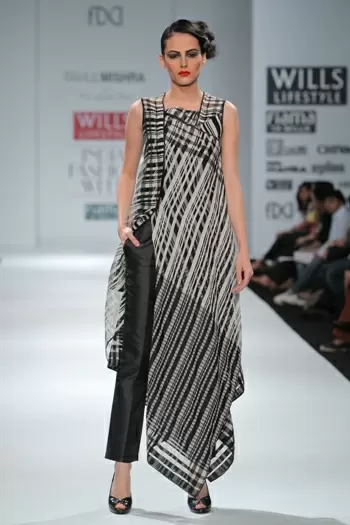Thanks to modern designers, khadi is going places and earning its pride of place
13-October-2011
Vol 2 | Issue 41
Once a symbol of India's independence movement popularised by Mahatma Gandhi, handspun khadi has got a makeover and become a style statement. It's no longer seen as a poor man's cloth, thanks to designers giving it a modern touch.
"Khadi has come to represent a handmade-in-India product of value and pride. And while it continues to be a symbol of freedom, it also represents an evolving India - the best of India's past endures in this ancient weave, yet it embraces elements of contemporary India to find a new synthesis and relevance," said designer Deepika Gehani.
 |
|
Huts to high streets: Khadi has come a long way to walk the ramps of top fashion shows (Photo: IANS)
|
Gehani showcased a successful khadi collection at the recent Lakme Fashion Week (LFW) and the Wills Lifestyle India Fashion Week (WIFW). She is one of the few designers who managed to give khadi a makeover by using her imagination and new techniques of weaving.
"Khadi blends that I developed in the year 2000 swept the traditional fabric to higher fashion echelons. I did it by blending khadi silk and khadi cotton with manmade eco-fibres 'tencel' and 'modal' (extracted from tree bark). This blend makes the fabric ideal for contemporary Indian as well as Western cuts," Gehani added.
Gandhiji advocated khadi as part of the independence movement and new age designers feel the handspun fabric connects with slogans like eco-friendliness and rural empowerment.
"Well after over 60 years of independence and definitely over about 75 years since Gandhi first began to spin the iconic fabric, the world has changed.
“Eco-friendly and rural empowerment have become new slogans and people with discerning tastes and social concerns are keen to continue the ideals of the Mahatma. It is but natural that khadi has moved out of the popular genre to a more elite class to an extent," said designer Wendell Rodricks.
Rodricks says khadi offers many design variations and this quality makes the fabric a global entity. "Khadi enjoys the endorsement of many designers," he said.
These days khadi silk and khadi cotton are finding prominence and khadi-viscose blends are also used extensively by stylists.
Rahul Mishra says he has showcased a "khadi collection in various forms like jumpsuits, skirts, tunics and trousers and, trust me, I can easily make lingerie and bustiers in khadi fabrics; so the designs are many."
He adds that fabrics look elegant when kept simple.
"There is no need to glamorise khadi. Those who want a minimal look with a deep sense of Gandhian aesthetics will enjoy khadi in its natural form. If you really want to go for bling and shimmer, then go for satins, linens and chiffons," he added.
"Silk khadi, which is available in a variety of hues and shades, adds elegance and a touch of royalty to any space. The dye gives the cloth a whole new dimension and looks great on cushions, tablecloths, runners, curtains, or sofa covers. Beautifully textured, sensuous and skin friendly, it also makes for great sofa covers," said Parul Jain.
With increased demand for khadi fabrics and with designers like Ritu Kumar, Sabyasaachi Mukherjee, Rahul Mishra and Anand Kabra using khadi extensively, it's is obvious that prices will shoot up.
The price of cotton khadi in local market is somewhere between Rs.34 and Rs.82 per metre, while if you want to buy a designer scarf, you may have to shell out Rs.4,000.
Rodricks feels with increased demand, prices have increased, but what worries him is the condition of weavers as they are not getting their due.
"Yes, the price has definitely increased because of the high demand. But what has not increased is the wage of workers who work hard to produce such fabrics," he added. - IANS














